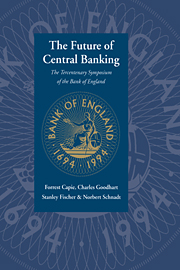3 - Central banking in transition
Published online by Cambridge University Press: 05 November 2011
Summary
Central banking has never been a static business. Throughout its long history it has performed different tasks in different periods; at the same time, developments have been far from identical in the various national central banks. In a long and broad historical perspective, central banking has always been in transition–just like most of our institutions in modern times.
But there is a sense in which the title of my paper is, I believe, justified. The financial systems of the developed world have been involved during the past twenty years or so in an exceptionally fast process of change, the end of which, moreover, is nowhere in sight. The expression ‘acceleration of history’ surely applies to the contemporary financial scene. The novelty does not lie only in the pace of change; it has also to do with the fact that change is occurring everywhere in the developed world, and even beyond. We now operate within an internationally integrated, innovative, highly competitive global financial system.
It is in this genuinely new environment that, over the last few years, central banking seems to have acquired enhanced importance–perhaps not in relation to its role at the time of the founding fathers, but surely in comparison with the perception of its role between the end of the Second World War and the early 1970s. Monetary policy has come to be regarded as the dominant element of macroeconomic policy, with the explicit mandate to ensure price stability.
- Type
- Chapter
- Information
- The Future of Central BankingThe Tercentenary Symposium of the Bank of England, pp. 330 - 341Publisher: Cambridge University PressPrint publication year: 1995
- 1
- Cited by



